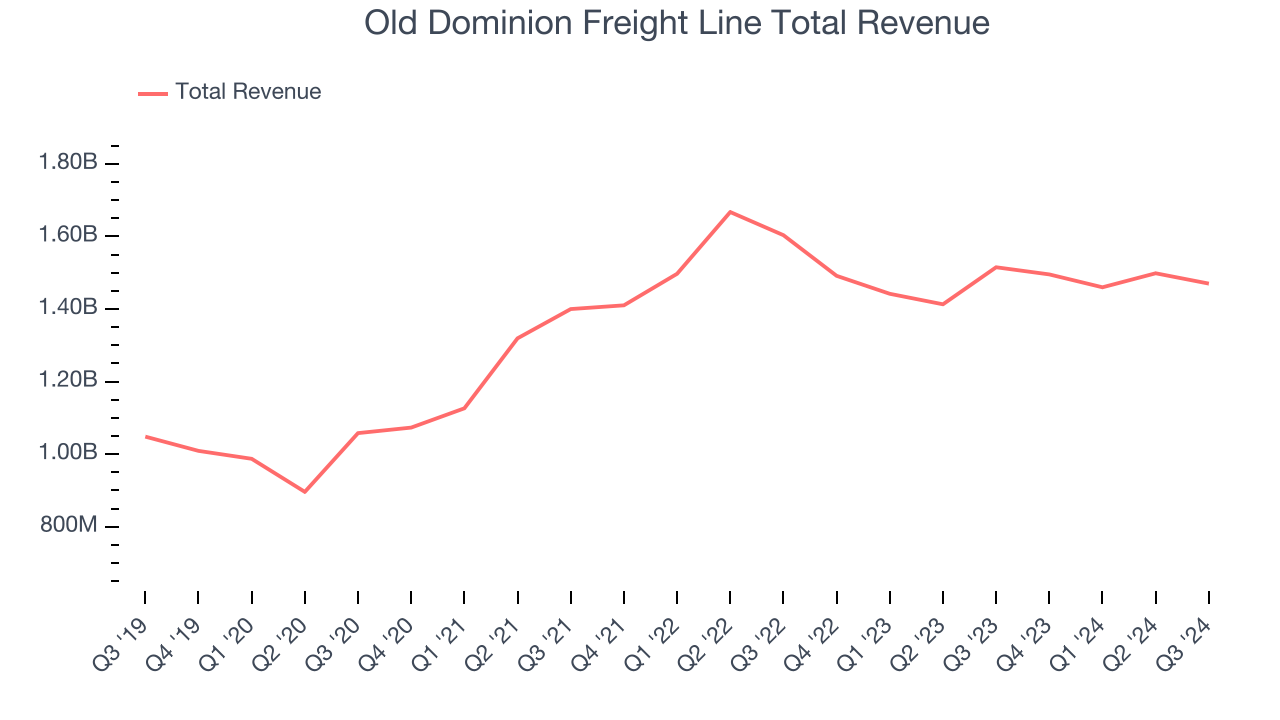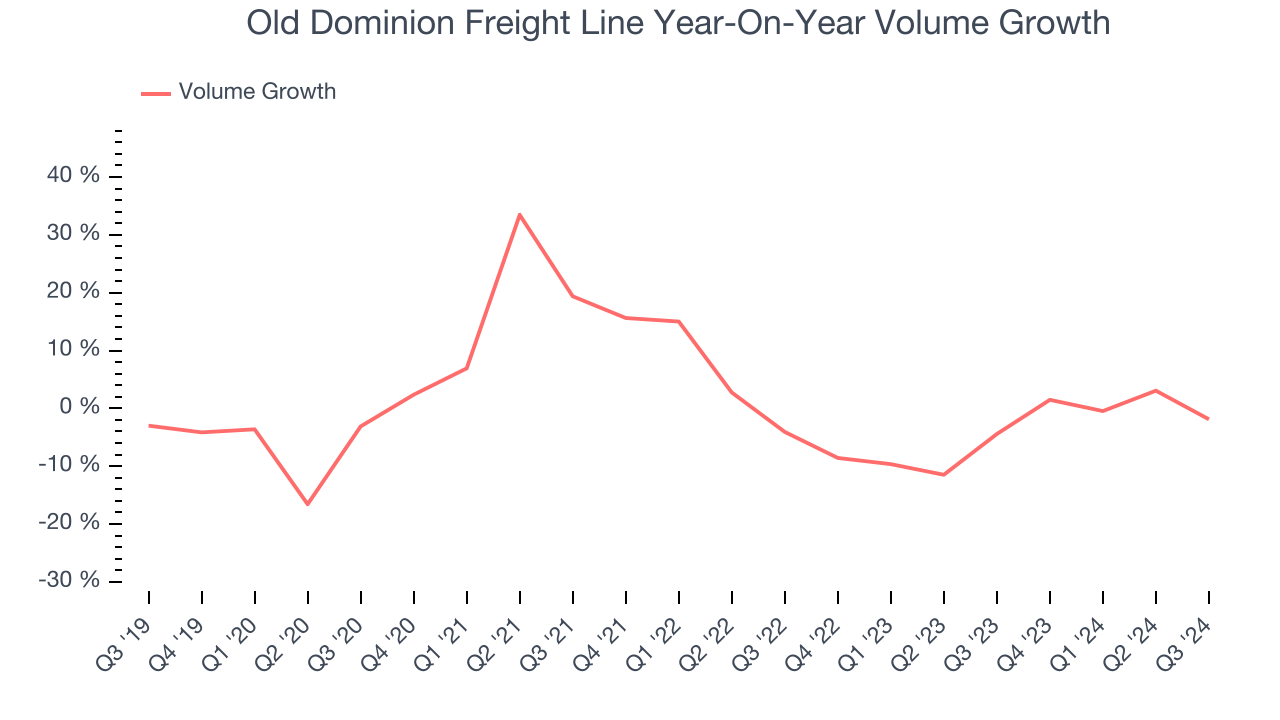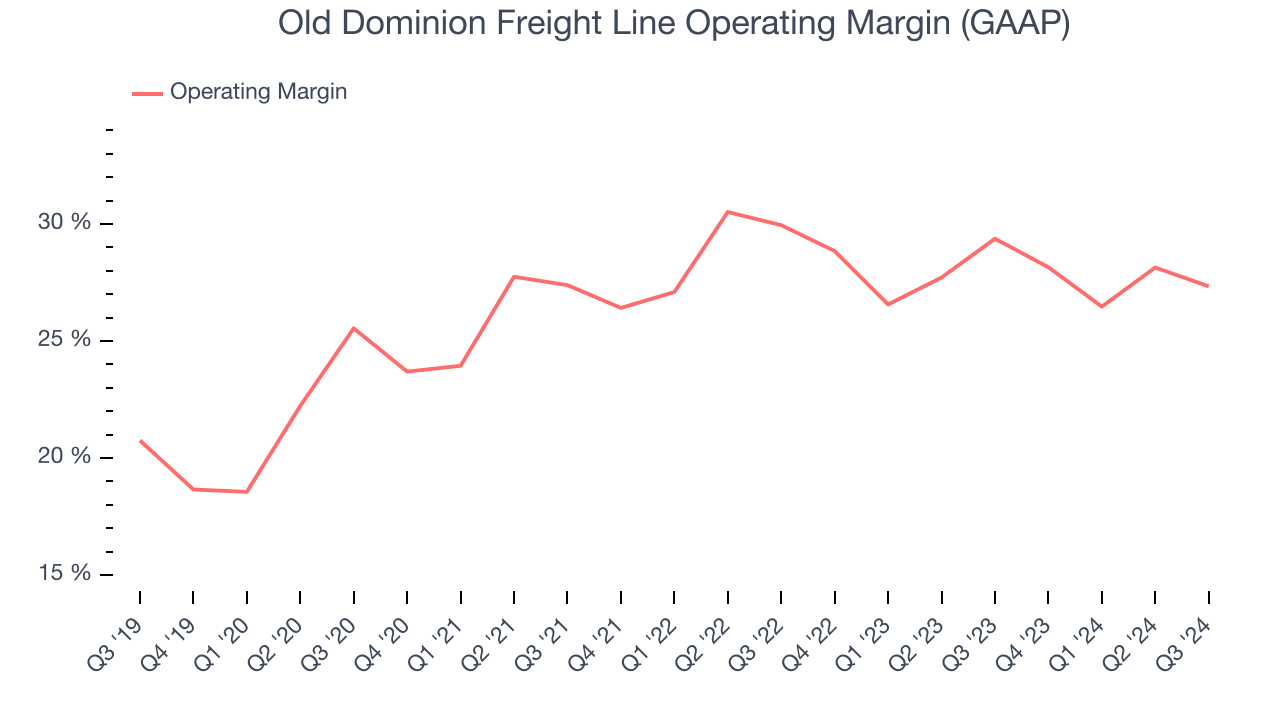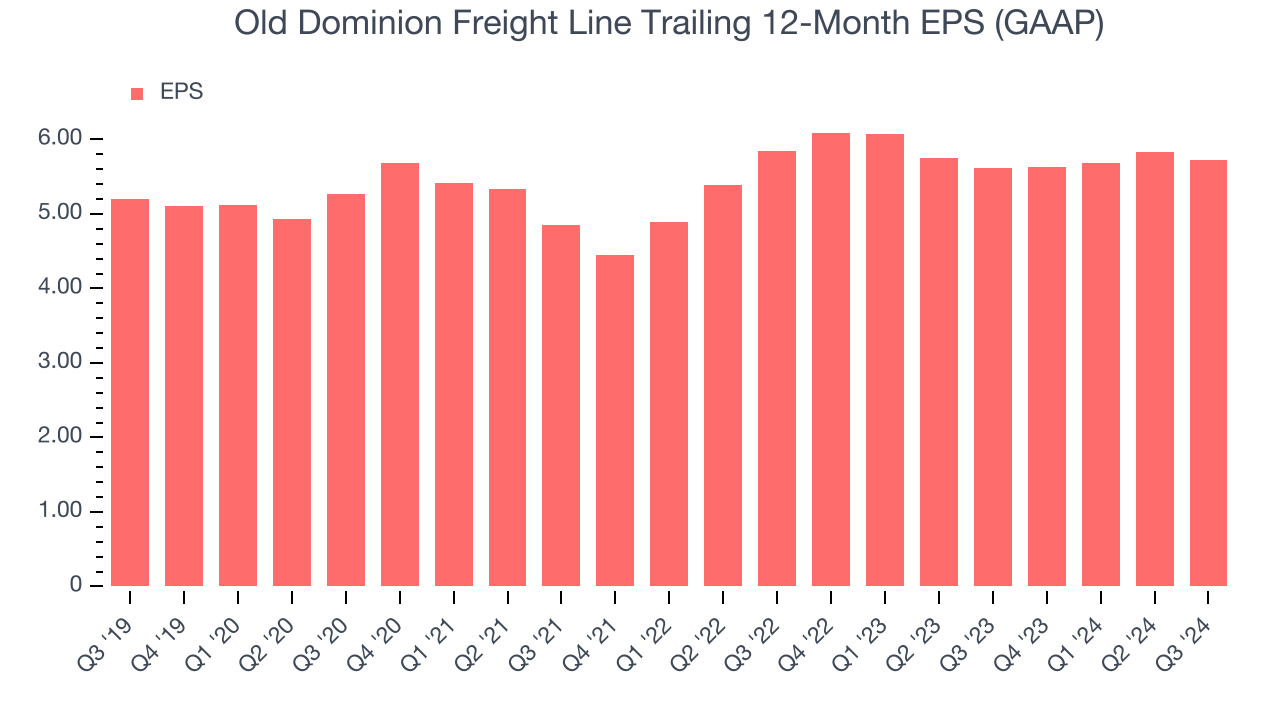
Freight carrier Old Dominion (NASDAQ:ODFL) missed Wall Street’s revenue expectations in Q3 CY2024, with sales falling 3% year on year to $1.47 billion. Its GAAP profit of $1.43 per share wasin line with analysts’ consensus estimates.
Is now the time to buy Old Dominion Freight Line? Find out by accessing our full research report, it’s free.
Old Dominion Freight Line (ODFL) Q3 CY2024 Highlights:
- Revenue: $1.47 billion vs analyst estimates of $1.49 billion (1.3% miss)
- EPS (GAAP): $1.43 vs analyst expectations of $1.42 (in line)
- EBITDA: $488.5 million vs analyst estimates of $497 million (1.7% miss)
- Gross Margin (GAAP): 40.3%, down from 41.5% in the same quarter last year
- EBITDA Margin: 33.2%, down from 34.9% in the same quarter last year
- Free Cash Flow Margin: 46.9%, up from 17.3% in the same quarter last year
- Sales Volumes fell 1.9% year on year (-4.4% in the same quarter last year)
- Market Capitalization: $42.76 billion
Marty Freeman, President and Chief Executive Officer of Old Dominion, commented, “Old Dominion’s third quarter financial results reflect ongoing softness in the domestic economy. The challenging operating environment, and strong comparable results for the third quarter of 2023, resulted in the first year-over-year decrease in our quarterly revenue and earnings per diluted share this year. Our market share and volume trends, however, remained relatively consistent with the first half of this year while our yield continued to improve. The consistency in our market share and yield performance continued to be supported by our best-in-class service, as we once again provided our customers with 99% on-time service and a cargo claims ratio of 0.1% during the quarter.
Company Overview
With its name deriving from the Commonwealth of Virginia’s nickname, Old Dominion (NASDAQ:ODFL) delivers less-than-truckload (LTL) and full-container load freight.
Ground Transportation
The growth of e-commerce and global trade continues to drive demand for shipping services, especially last-mile delivery, presenting opportunities for ground transportation companies. The industry continues to invest in data, analytics, and autonomous fleets to optimize efficiency and find the most cost-effective routes. Despite the essential services this industry provides, ground transportation companies are still at the whim of economic cycles. Consumer spending, for example, can greatly impact the demand for these companies’ offerings while fuel costs can influence profit margins.
Sales Growth
A company’s long-term performance is an indicator of its overall business quality. While any business can experience short-term success, top-performing ones enjoy sustained growth for multiple years. Unfortunately, Old Dominion Freight Line’s 7.5% annualized revenue growth over the last five years was mediocre. This shows it couldn’t expand in any major way and is a tough starting point for our analysis.

We at StockStory place the most emphasis on long-term growth, but within industrials, a half-decade historical view may miss cycles, industry trends, or a company capitalizing on catalysts such as a new contract win or a successful product line. Old Dominion Freight Line’s history shows it grew in the past but relinquished its gains over the last two years, as its revenue fell by 2.1% annually. Old Dominion Freight Line isn’t alone in its struggles as the Ground Transportation industry experienced a cyclical downturn, with many similar businesses seeing lower sales at this time.
We can dig further into the company’s revenue dynamics by analyzing its sales volumes, which reached 3.07 million in the latest quarter. Over the last two years, Old Dominion Freight Line’s sales volumes averaged 4% year-on-year declines. Because this number is lower than its revenue growth, we can see the company benefited from price increases. 
This quarter, Old Dominion Freight Line missed Wall Street’s estimates and reported a rather uninspiring 3% year-on-year revenue decline, generating $1.47 billion of revenue.
Looking ahead, sell-side analysts expect revenue to grow 4% over the next 12 months, an acceleration versus the last two years. Although this projection shows the market thinks its newer products and services will fuel better performance, it is still below average for the sector.
When a company has more cash than it knows what to do with, buying back its own shares can make a lot of sense–as long as the price is right. Luckily, we’ve found one, a low-priced stock that is gushing free cash flow AND buying back shares. Click here to claim your Special Free Report on a fallen angel growth story that is already recovering from a setback.
Operating Margin
Operating margin is a key measure of profitability. Think of it as net income–the bottom line–excluding the impact of taxes and interest on debt, which are less connected to business fundamentals.
Analyzing the trend in its profitability, Old Dominion Freight Line’s annual operating margin rose by 6.2 percentage points over the last five years, showing its efficiency has meaningfully improved.

In Q3, Old Dominion Freight Line generated an operating profit margin of 27.3%, down 2 percentage points year on year. Since Old Dominion Freight Line’s operating margin decreased more than its gross margin, we can assume it was recently less efficient because expenses such as marketing, R&D, and administrative overhead increased.
Earnings Per Share
Analyzing long-term revenue trends tells us about a company’s historical growth, but the long-term change in its earnings per share (EPS) points to the profitability of that growth – for example, a company could inflate its sales through excessive spending on advertising and promotions.
Old Dominion Freight Line’s EPS grew at a weak 1.9% compounded annual growth rate over the last five years, lower than its 7.5% annualized revenue growth. However, its operating margin actually expanded during this timeframe, telling us non-fundamental factors affected its ultimate earnings.

Like with revenue, we analyze EPS over a more recent period because it can give insight into an emerging theme or development for the business. Although it wasn’t great, Old Dominion Freight Line’s two-year annual EPS declines of 1% topped its two-year revenue performance.
In Q3, Old Dominion Freight Line reported EPS at $1.43, down from $1.54 in the same quarter last year. This print was close to analysts’ estimates. Over the next 12 months, Wall Street expects Old Dominion Freight Line’s full-year EPS of $5.72 to grow by 3.1%.
Key Takeaways from Old Dominion Freight Line’s Q3 Results
It was encouraging to see Old Dominion Freight Line beat analysts’ volume expectations this quarter. On the other hand, its revenue unfortunately missed and its EBITDA fell short of Wall Street’s estimates. Overall, this was a softer quarter. The stock traded down 2.8% to $194 immediately after reporting.
The latest quarter from Old Dominion Freight Line’s wasn’t that good. One earnings report doesn’t define a company’s quality, though, so let’s explore whether the stock is a buy at the current price.We think that the latest quarter is only one piece of the longer-term business quality puzzle. Quality, when combined with valuation, can help determine if the stock is a buy.We cover that in our actionable full research report which you can read here, it’s free.
